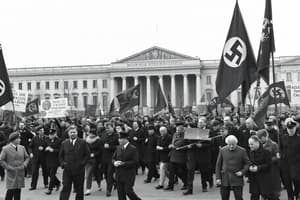Podcast
Questions and Answers
What was the primary context in which fascist movements emerged?
What was the primary context in which fascist movements emerged?
- Interwar Europe (correct)
- Post-World War II era
- Post-cold war era
- During the Industrial Revolution
Which of the following is a key characteristic of fascist ideology?
Which of the following is a key characteristic of fascist ideology?
- Emphasis on individualism
- Advocacy for a classless society
- Glorification of violence and conquest (correct)
- Rejection of collectivism
What was the primary inspiration for communist ideology?
What was the primary inspiration for communist ideology?
- The teachings of Marx and Engels (correct)
- The ideas of social Darwinism
- The writings of Mussolini
- The principles of liberal democracy
What was the outcome of the Bolshevik Revolution of 1917?
What was the outcome of the Bolshevik Revolution of 1917?
What is a key difference between fascist and communist ideologies?
What is a key difference between fascist and communist ideologies?
What is a common goal shared by fascist and communist regimes?
What is a common goal shared by fascist and communist regimes?
What is the primary goal of communist economies?
What is the primary goal of communist economies?
What is a characteristic of fascist economies?
What is a characteristic of fascist economies?
What is the ultimate goal of communism?
What is the ultimate goal of communism?
How do fascist regimes typically promote their ideology?
How do fascist regimes typically promote their ideology?
What is a criticism of communist states?
What is a criticism of communist states?
What is a commonality between fascist and communist regimes?
What is a commonality between fascist and communist regimes?
Flashcards are hidden until you start studying
Study Notes
Historical Context and Emergence
-
Fascism emerged in interwar Europe, responding to WWI's aftermath, economic turmoil, and liberal democracy's perceived failures.
-
Fascist movements, like Italy under Mussolini and Germany under Hitler, capitalized on nationalist sentiments, promising order, national pride, and economic stability.
-
Communism originated from the socio-economic conditions of industrial capitalism in the 19th century.
-
The writings of Marx and Engels provided a theoretical framework critiquing capitalism and advocating for a classless society.
-
Communism gained traction in the early 20th century, particularly in Russia with the Bolshevik Revolution of 1917, leading to the establishment of the Soviet Union.
Ideological Underpinnings
-
Fascism emphasizes the nation or ethnic group, exalting the state and its leader as embodiments of national will and strength.
-
Fascism incorporates elements of social Darwinism, glorifying violence and emphasizing the necessity of conflict and conquest to achieve national greatness.
-
Fascism rejects individualism in favor of collectivism, within a framework of strict hierarchy and obedience.
-
Communism is rooted in the critique of capitalism and the belief in historical materialism, positing that class struggle drives societal change.
-
Communism envisions the eventual establishment of a classless, stateless society where the means of production are owned collectively and wealth is distributed according to need.
Economic Systems and Policies
-
Fascist economies typically adopt a corporatist economic model, where the state collaborates with private businesses under its supervision.
-
This collaboration aims to coordinate economic activity in service of national goals, such as militarization and territorial expansion.
-
Fascist economies are characterized by protectionism, state intervention, and a focus on autarky (economic self-sufficiency).
-
Communism advocates for the collective ownership of the means of production, implemented through centralized planning and state control.
-
Communist regimes nationalize industries, abolish private property, and establish state-run enterprises.
-
The planned economy aims to allocate resources efficiently, prioritize societal needs, and eliminate the exploitation inherent in capitalist systems.
Social and Cultural Dynamics
-
Fascism promotes a homogenized national identity based on ethnicity, culture, and often race.
-
Fascist regimes use propaganda, censorship, and state-controlled media to propagate their ideology and suppress dissent.
-
They often espouse traditional values, patriarchal gender norms, and strict social hierarchies, while scapegoating minorities and promoting a cult of personality around the leader.
-
Communism aspires to create a classless society where all individuals are equal regardless of class, race, or gender.
-
Communist regimes implement policies aimed at eradicating social inequalities, promoting education and healthcare, and fostering a sense of solidarity among the working class.
Control Mechanisms in Fascism and Communism
- Both fascism and communism emphasize control mechanisms, such as propaganda, censorship, and state-controlled media, to propagate their ideologies and suppress dissent.
Studying That Suits You
Use AI to generate personalized quizzes and flashcards to suit your learning preferences.




